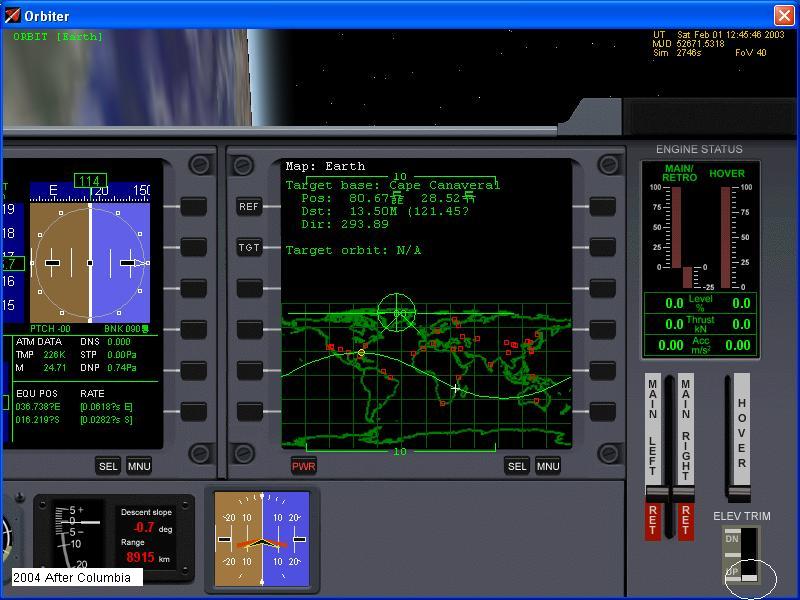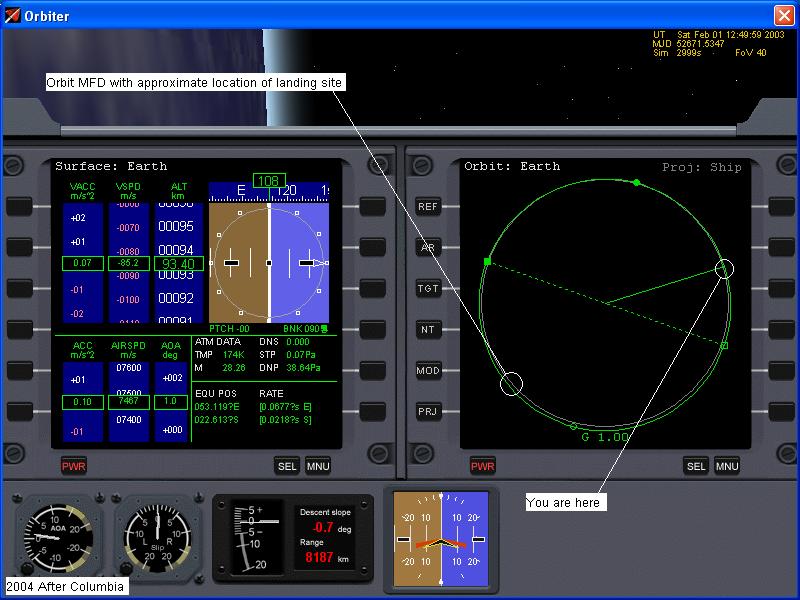|
Entry Checklist (to be completed prior to reaching 122km altitude)
1. Make sure all external openings are closed (Delta Glider: Docking Port Doors, Landing Gear, Radiator
compartment and Ku-band antenna; Shuttle: Payload Bay, Air Data Probe, ET disconnect doors, Ku-band antenna)
2. Set MFD (Multiple Function Display) of your choice to Surface using Shift-S (may need to Shift-Q
to exit Orbit MFD if applicable)
3. Set other MFD to Map MFD using Shift-M (may need to Shift-Q to exit Orbit MFD if applicable) and
make sure that target is set to Cape Canaveral or other desired target base using Shift-T.
3b. If you are using an EntryMFD, then set the other MFD to the EntryMFD. (EntryMFD needs to
be activated under the Modules tab of the Launch Pad after installation; Delta Glider will forget its trim setting.)
4. Set RCS control to OFF using the rotary switch. Prograde Autopilot will still have RCS authority.
5. Set AF Control to ON, which will allow control during entry.
6. Set the trim setting to the maximum pitch up trim.
7. Turn off Prograde Autopilot at 120km or lower (higher and vehicle might rotate and oscillate prior
to atmospheric control becoming effective.)
8. Observe dynamic oscillations, vehicle should stabilize at an angle of attack or "alpha" (indicated
on Surface MFD by "AOA deg" and by the AoA dial in the panel's lower left) of +1.3 degrees (40 degrees for Shuttle) and a
sideslip, or "beta" of 0 degrees (also 0 degress for Shuttle.)

The guidance system must dissipate the tremendous amount of energy the Orbiter possesses when it
reenters the Earth's atmosphere to ensure the Orbiter does not either burn up (entry angle too steep) or skip back out of
the atmosphere (entry angle too shallow). During reentry, excess energy is dissipated by atmospheric drag on the Orbiter...
In this flight, I am the guidance system as the Delta Glider's pilot. Because the Delta Glider is tough and can
handle a low angle of attack (the Shuttle needs to use a high angle of attack to maintain a high lift coefficient, and therefore
altitude, and also to distribute the heat around the Orbiter's base.), and also dynamically stable and capable of hands
off operation (on the Shuttle, if all five GPC's including both PASS and BFS were to completely fail, the Shuttle would be
uncontrollable..even with both hands of both flight crew members on the stick.) The futuristic, but still
realistic Delta Glider has a standard L/D of 3.75 (variable, up at 3.95 at entry interface and slowly decreasing) with a reserve
mode (Ctrl-pitch control for fine elevon control) that goes up to an L/D of 5.5, providing an energy reserve. In addition
to all this, the Delta Glider's main engines will still work in the atmosphere, at any speed and altitude, allowing energy
to be added to a slow trajectory, although a fast trajectory can still be dangerous. Compared to the Shuttle, the Delta
Glider is a pussy cat (until final approach that is...) and is therefore possible, although still very difficult, to deorbit,
enter and land manually. The Shuttle for Orbiter is not modelled realistically enough for entry to be as difficult as
it really would be.
Space Shuttle is operating at its limits, and has very small margins for entry compared to Delta Glider. Despite
all this, I have yet to land the Delta Glider successfully without any application of power and without using the elevon control
reserve.

|
| From this early entry view, we are travelling counterclockwise over halfway around the world to land |
While I enter the Delta Glider completely under aerodynamic control, the Shuttle transitions incrementally from RCS thrusters
to aerodynamic controls on this schedule:
Entry Interface: Forward RCS pod is deactivated immediately, as its plumes can travel back in the
airstream and impact other Orbiter surfaces.
2.0 psf / 0.096 kPa, Surface MFD will show 95.88 Pa: (note view above is 38.64 Pa) Elevon and Body Flap control becomes effective in pitch, and pitch RCS thrusters
are deactivated, while there is some roll control, RCS roll thrusters are still needed; Delta Glider controls have little
effect, do not touch them as it can cause a rotation that is difficult to correct.
5.0 psf / 0.240 kPa, Surface MFD will show 239.70 Pa; While this event is not governed by dynamic
pressure, it is approximately when the Shuttle Guidance begins to "touch the controls" so to speak, and do more than stabilize
the initial wings level attitude. The event is called "Closed Loop Guidance Initialization" or "CLG Init" for short,
and is marked on STS-107 as Master Timeline event 17.5 at EI+298, or 5 minutes.

The above screenshot was taken as the accelleration reversed from positive to negative, meaning that the atmosphere is
slowing me down, more than gravity is speeding me up. This accelleration indicator does not emulate a gee-meter type
of accellerometer, but shows true accelleration including the effects of gravity. Linear accelleration (as
opposed to directional accelleration) due to gravity is approximately a hundredth of a gee so the equivalent moment for STS-107
is marked in the on board video by Willie McCool saying "I let go of the card and it falls," and Rick Husband noticing on
his instruments that the accellerometer displayed 1/100g. Dynamic pressure is about 9 psf. Controls have
become effective enough that I have become to level out the bank to reduce the sink rate, shown by "VSPD m/s" on the Surface
MFD. Here, I want to reduce VSPD to 20 m/ s and gradually increase drag, as shown by "ACC m/s2" in the lower left of
the Surface MFD.
10 psf / 0.479 kPa (Instrument shows 479.4Pa) The Shuttle's Roll RCS thrusters are deactivated.
Because of the high angle of attack experienced by Shuttle, yaw jet firings are needed to do major roll maneuvers or corrections.
You might remember that during STS-107, 2 of the yaw thrusters were firing at loss of signal. along with a rapid change in
the roll trim of the vehicle in progress to fight errant forces related to the disaster.
At this point, both Delta Glider and Shuttle are in the ideal control configuration for most of entry. This is
also the beginning of the Peak Heating Region. Also, pitch adjustments are not used to adjust drag as they cause massive
variations in temperatures on Shuttle (lowering angle of attack for Shuttle too early causes the leading edge and nose to
overheat, as well as hotspots on what is supposed to be the cool upper side of the Orbiter. In Delta Glider, which is
immune to thermal effects, it will cause huge drag oscillations that will tend to lead either to skip out or diving too steep
and falling thousands of miles short.) Both Shuttle and Delta Glider can use small pitch adjustments (the pitch reserve
I mentioned earlier for Delta Glider; it is known as "alpha modulation" in Shuttle-speak, and has been implemented since the
Shuttle entered service.)
Normally, the angle-of-attack and roll angle enable the atmospheric drag of any
flight vehicle to be controlled. However, for the Orbiter, angle-of-attack variation was rejected because it creates
exterior surface temperatures in excess of the insulation capabilities of the thermal protection system. The angle-of-attack
schedule is loaded into the GPCs as a function of relative velocity, leaving only roll angle for energy control. Increasing
the roll angle decreases the vertical component of lift (as the cosine of the bank
angle multiplied by wings level lift, for those who want to know exactly.) causing a
higher sink rate and a higher energy dissipation rate. Increasing the roll angle raises the surface temperature of the
Orbiter, but not as drastically as an equivalent angle-of-attack variation.
Delta Glider Initial Entry:
1. Observe DNP, when it reaches 250Pa, reduce the roll angle. If the vehicle does not respond, make sure that Prograde
autopilot is turned off.
2. Observe VACC. Roll right until VACC is about +1.00m/s^2
3. Observe VSPD and VACC. Maintain VACC at about +1.00m/s^2, if VACC is high, roll left away from level.
If VACC is low, roll right towards level.
4. When VSPD approaches -10 m/s, roll left away from wings level until VACC reaches 0.00m/s^2.
5. Observe ACC; it should read about 0.11m/s^2 and increasing.
|

